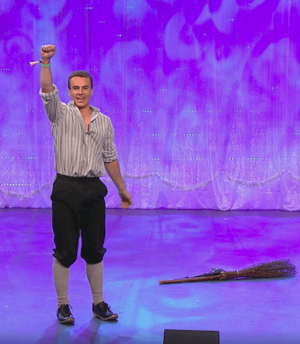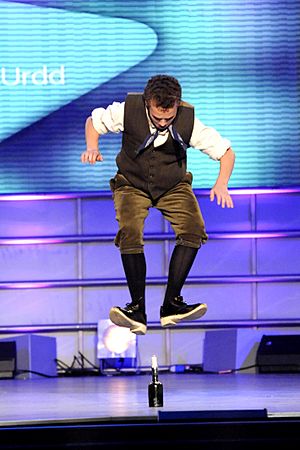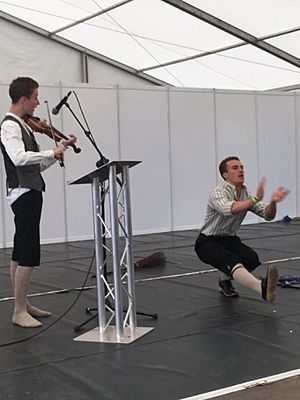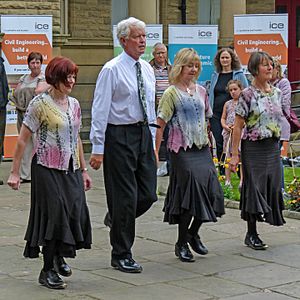Clog dancing facts for kids
Clog dancing is a lively type of step dance. Dancers wear special shoes called clogs, which have stiff, wooden soles. The main idea is to make different sounds and rhythms with your feet!
Clog dancing grew into many different styles in both Wales and the North of England. In Wales, it often started in slate mines. Workers would challenge each other during breaks to see who could do the best steps. In Northern England, it came from areas like Lancashire, Yorkshire, and Northumberland.
Long ago, clogs were everyday shoes for working people across Britain. They had leather tops and soles made from wood like alder or sycamore. Dancing clogs fit snugly, which helps dancers control their foot movements better. Some English clogs even have iron or rubber on the sole. These are also used in North West morris dancing.
Dancers focus a lot on their footwork. They can create many cool sounds just by tapping their feet. Clog dancing was often done casually. People would dance at home, in pubs, or on the street. Dancers kept their upper bodies still, so they didn't need much space.
In the 1800s, clog dancing became a popular sport with competitions. Dancers could win or lose a lot of money! Like jockeys today, dancers wore special colours to be easily seen. Both men and women wore breeches, which showed off their leg movements. Clog dancing was also a big hit on stage. During the Victorian era, it was a popular act in music halls and variety shows. Performers often wore fun, themed costumes. The famous comedian Charlie Chaplin even started his career as a clog dancer in music halls.
Welsh clog dancing is still very much alive today. You can see it at many festivals in Wales, especially the National "Eisteddfodau." These include the Urdd National Eisteddfod and the National Eisteddfod of Wales. These big events happen in a different part of Wales each year. Welsh clog dancing can be performed by groups or by individuals. Male solo dancers often do amazing "tricks" at the end of their performance. This means Welsh male dancers need to be very athletic!
English clog dancing also continues at some festivals in Northumbria. It's danced to the traditional music of that area. You can still find clog dancing in parts of Lancashire, Cheshire, and Yorkshire. There are also teams dancing these traditional styles in many other parts of England. Competitions in England include the Lancashire and Cheshire Clog Dancing Contests. These happen every September in Fleetwood. There are also the Northern Counties Clog Dancing Championships in Tyne and Wear.
Contents
Welsh Clog Dancing: A Closer Look
For more details, see the main article: Welsh Clog Dancing
Where It Began
Clog dancing in Wales mostly started in slate quarries and among farmers. Workers would try to out-do each other during breaks. They would show off fancy "steps" and "tricks" to impress their friends. The flat slate from the quarries was a perfect surface for dancing. Even today, slate is sometimes used in "eisteddfod" competitions.
Unique Style
Welsh clog dancing is special because it's an unbroken tradition. This means it has been passed down through generations without stopping. It's different from English clog dancing. New steps and "tricks" are always being created for Eisteddfod competitions. For example, dancers might put out a candle with their clogs. They might do "toby stepping," which is moving forward in a squat. Other tricks include straddle jumps, handkerchief jumps, and jumping over brooms. Welsh solo clog dancing has become very active and exciting.
Modern Competitions
Clog dancing is a key part of the eisteddfod tradition in Wales. Since the 1960s, competitions have grown to include duets and trios. This allows groups to show how dancers would try to out-perform each other. Group clogging is also a big part of these festivals. The competitions can be very energetic, with dancers leaping over brooms!
Some famous Welsh dancing groups are the Nantgarw Dancers and Talog dancers. Both have won many awards at the National Eisteddfod. Nantgarw dancers have also done well in international events. These include the Llangollen International Eisteddfod in Wales and the Lorient Folk Festival in France.
English Clog Dancing: Styles and History
Today, there are three main styles of English clog dancing:
- Northumberland and Durham style: This style looks a bit like Irish dancing. Dancers make small, precise body movements. Their upper body stays almost completely still. They wear flat clogs and use a lot of heel steps.
- Lancashire style: This style is very different from Northumbrian clogging. It's much more showy and lively. Dancers keep their heels off the ground. In competitions, using heel steps can get you disqualified! They wear special 'Dandy' clogs with extra details.
- Lakeland style or Westmorland Reel: This is usually danced as a reel. It has eight bars of stepping, followed by a reel of three dancers.
A Look Back in Time
English clog dancing started in the 1700s during the Industrial Revolution. It's thought to have grown in the Lancashire cotton mills. Workers there preferred wooden-soled clogs because the floors were often wet. This helped keep the air humid, which was important for spinning cotton. During breaks, workers would have competitions. They were judged on who could make the best rhythm patterns.
Workers danced in their everyday clogs on the street, in pubs, and at social events. By the late 1800s, clog dancers performed on proper stages in competitions. Judges looked at footwork, precision, and technique. Clog dancers were a common sight in music halls throughout the 19th and early 20th centuries. The Eight Lancashire Lads was one such group, and a young Charlie Chaplin was a member! Dan Leno became the world champion clog dancer in the 1880s.
Cecil Sharp and Maud Karpeles were important people who wrote down many English folk dances. Maud Karpeles documented groups of North West morris dancers. Her book The Lancashire Morris Dance was published in 1930. It included music for common Morris tunes.
In the USA, English clog steps mixed with African rhythms. This created "buck and wing dancing," which later turned into Tap dance. Today, clog dancers might wear clogs, tap shoes, or hard-soled shoes, depending on the style. You can find these dances in the North East, the Lake District, and Lancashire. Competitions have also helped define some of the styles. Competition dancing often focuses on very precise footwork with little upper-body movement.
What Dancers Wear
Today, clog dancers wear different costumes. Some are inspired by the clothes of northern workers from the Victorian and Edwardian eras. In Lancashire and Northumbria, some female dancers have special costumes. These often include a waistcoat or bodice with a shawl, a long skirt, and an apron with floral patterns. Dancers also wear modern clothing.
Pat Tracey, a dancer, described what street dancers wore in the early 1900s. They usually wore their normal working clothes. This included brown trousers, a striped shirt, a red scarf, a navy blue jacket, and a soft cap. They danced in their everyday clogs, which were lighter than the ones most weavers wore. Some dancers now wear clothes like mill workers or their "Sunday best." Others choose more modern outfits.
Current Traditions and Festivals
Clog dancing is still performed at some festivals in North East England. It's usually danced to the traditional music of Northumbria. Dancing traditions also continue in Lancashire, Cheshire, Yorkshire, Cumbria, and Derbyshire.
Clog dance competitions in England include the Lancashire and Cheshire Clog Dancing Contests. These focus on the Lancashire style and happen every September as part of the Fylde Folk Festival in Fleetwood. The Northern Counties Clog Dancing Championships focus on Durham and Northumberland styles. They are held every year in Tyne and Wear.
Clog Dancing Around the World
Dutch Clog Dancing
In the Netherlands, traditional dancing is sometimes called "Klompendansen," which means "clog dancing." Wooden shoes are a key part of the traditional costume. Clogs made for dancing are lighter than the old, heavy designs. They have ash wood soles and a lower cut around the ankle. Dancers create rhythms by tapping their toes and heels on a wooden floor.
Clog Dancing in the USA
In the United States, a style called "team clogging" started from square dance teams. This happened in Asheville, North Carolina, at the Mountain Dance and Folk Festival in 1928. It's found in the Appalachian region.
American Clogging is linked to "old-time" music, which comes from fiddle tunes from the British Isles. Clogging grew from English, Welsh, German, and Cherokee step dances. It also includes African rhythms and movements. Tap dance actually developed from clogging!
Solo dancing, outside of big circle dances, has different names like buck dance, flatfooting, and jigging. These names can mean slightly different things. Buck dancing was an early mix of shuffle and tap steps. It used rhythms where the accents were on the downbeat or offbeat. This style came mainly from African tribal music.
Traditional Appalachian clogging uses loose, bent knees. Dancers often "drag-slide" their feet across the floor. It's usually danced to old-time music.
See also
- Step dance







